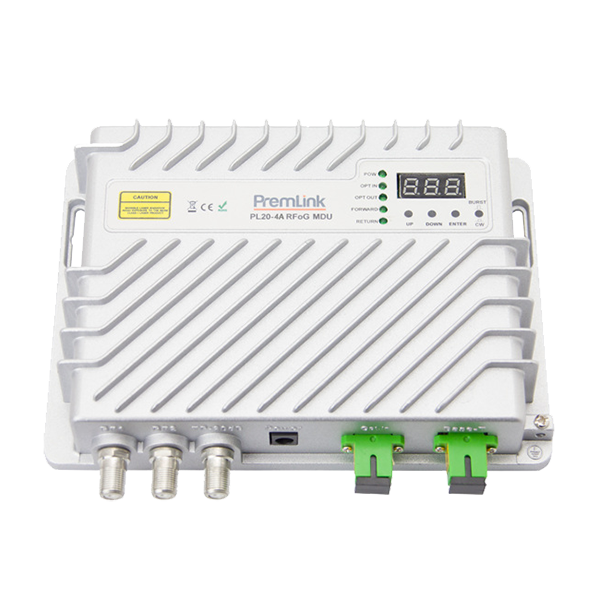What is RF over Glass (RFoG)?
RF over Glass: In telecommunications, radio frequency over glass is a deep-fiber network design in which the coax portion of the hybrid fiber coax (HFC) network is replaced by a single-fiber passive optical network (PON). Downstream and return-path transmission use different wavelengths to share the same fiber (typically 1550 nm downstream, and 1310 nm or 1590/1610 nm upstream).
The return-path wavelength standard is expected to be 1610 nm, but early deployments have used 1590 nm, somewhere CWDM wavelength ( e.g, 1510, 1530, 1570…) in us. Using 1590/1610 nm for the return path allows the fiber infrastructure to support both RFoG and a standards-based PON simultaneously, operating with 1,490 nm downstream and 1,310 nm return-path wavelengths. The RFoG system ends at the subscriber side interface of an RFoG Optical Network Unit (R-ONU) at the home.
The Technology Background of RF over Glass
RFoG technology is an HFC access network solution based on a cable TV fiber optic network with RF transmission as the primary business. In 2007, the US company called Alloptic (all-optical network) was the first to develop RFoG technology and related products, and it promoted this technical solution to several cable TV operators in North America.
So currently, a lot countries throughout the world have adopted this technology. In 2007, the Society of Cable Television Engineers (SCTE) accepted RFoG’s standard development plan.
The Interface Practice Subcommittee of SCTE began developing a series of interface standards in March 2008, enabling the newly added passive FTTH network to interconnect with existing HFC networks and front-end devices, and ensuring that traditional digital TV set-top boxes and DOCSIS compliant modems are compatible with passive FTTH networks. Users just need to install an optoelectronic converter at home to view high-definition TV, while also enabling value-added services such as VOD video playback and broadband internet access.
In 2010, the SCTE organization formally released the RFOG FTTH technical definition, “ANSI/SCTE174-2010 Radio Frequency over Glass Fiber to the Home Specification”.


What is RFoG Architecture?
RFoG (RF over Glass) regularly gets deployed with two architecture types:
Passive: 32 split over 20 km that comply with the requirements for PON; no active devices in the facility.
Hybrid: active field optics (EDFA, return Rx/Tx) are used to conserve or expand the reach of the fiber.
Customers located beyond of the 20 km radius can also be served by lowering the split ratio (up to 48 km). Alternatively, if the distance is reduced, the split ratio can be raised.
The RFoG (RF over Glass) combined xPON (GPON or XGSPON & GPON co-exsitence) can be deployed as an extension of the installed HFC network. Cable operators can also adopt a GPON or XGSPON design that includes the RFoG return path, allowing them to continue to use existing premises equipment.
Downstream GPON/XGSPON & GPON co-exsitence traffic travels from operator’s data network to an OLT, which routes it to a WDM device with 1310 and 1490 nm or 1277 and 1570nm wavelengths. The CMTS converts DOCSIS and video communication to optical traffic, which is then sent to a WDM platform via an EDFA amplifier ( The EDFA combined WDM device into one unit called EDFA PON Combiner) for longer distances. The WDM device distributes traffic through a splitter to a mini node at the customer’s premises. The mini node then transfers video, voice, and data traffic over coax.
All return path traffic is converted to optical by the mini node and sent over a 1590 nm or 1610nm (CWDM) wavelength to the headend, where an optical receiver converts it and sends it through a CMTS for access to voice, data, and video network resources. This solution allows cable operators to implement a “mixed system” supporting both GPON/XGSPON & GPON co-exsitence and DOCSIS services.
Cable providers can operate RFoG and GPON/XGSPON & GPON co-exsitence solutions in the same area with advanced design considerations, allowing for neighbors to receive services from both. A WDM platform separates RFoG and GPON/XGSPON & GPON co-exsitence, and cable operators can gradually transition subscribers to a GPON/XGSPON solution based on market demands.
Initially, the cable operator would set up an RFoG mini node with a xPON optical expansion connection. The xPON-specific wavelengths, 1490 and 1310 nm or 1277 and 1570nm, are routed to the expansion port. If a cable operator needs to provide more Ultra-Broadband services to a specific residence, such as higher-speed symmetrical data service or IPTV, a GPON/XGSPON ONT can be connected to the expansion port. The RFoG small node can continue to provide standard video services and manage legacy return signals as needed.
What is the Standard for RFoG Technology?
RFoG follows up with SCTE standards, document release history as below:
SCTE 174 2010 in year 2010
SCTE 174 2018 in year 2018
SCTE 174 2018 (R2024) in year 2024






